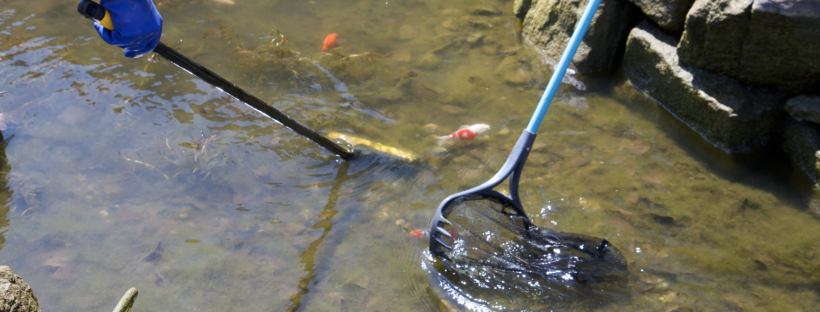Well, it’s finally here, a month late in my neck of the woods, but worth waiting for. Time to get your pond up and running after a long, cold winter!
Step 1
The first step is to remove any pond netting installed in the fall. It may be heavy with leaves and debris that have accumulated over the winter. This is good news, because anything trapped in the net would have settled to the bottom of the pond. Clean and dry the net. Use zip ties to repair small tears before storing, you’ll need it next fall.
Step 2
The next step is to clean the filter media without killing all the beneficial bacteria living there. Those are the bacteria that convert toxic ammonia that your fish excrete continuously to harmless nitrates. They cannot survive drying, and your fish can’t live without them. Get a couple of suitably sized buckets and fill them with pond water. Rinse any bagged media in the pondwater and leave the media in the bucket, to prevent the biofilm from drying out. Then take the top filter pad out, rinse it in the other bucket of pond water, and leave it there. Don’t worry about getting it really clean; the bacteria is what counts and you’ve saved enough to reseed the filter.
Step 3
Now you can pull out the remaining filter mat(s) and clean out the FilterFalls with a hose or wet/dry vac. The closer to the bottom the mat is, the more gunky it will be, and will probably need more aggressive cleaning. Use the hose and rinse the other mat or mats really well. The chlorinated water will kill whatever bacteria remain but that’s ok. When you’re ready to reassemble the filter, the clean mats will go back on top of the mat you kept in pond water. When the pump turns on, the flow of water up through the biologically active mat will help recolonize the top pads.
Step 4
Now for the skimmer. Begin by removing the debris net, mat or brushes and clean them well. In the skimmer the bacteria don’t matter as much as ensuring that water reaches the pump. If your pump and check valve overwintered in the skimmer, remove and clean them now. If removed in the fall, clean and inspect your pump and check valve. Lock the weir door into the closed position and remove any debris in the bottom of the skimmer with a wet/dry vac. Reinstall the pump, check valve, net, mat and/or brushes. If you have an auto-fill installed inside the skimmer, test to make sure it is working properly and adjust the level if necessary.
Unlock the weir door and replace the skimmer lid.
Step 5
Remove as much debris as possible from the stream and pond before starting your pump. Remove algae and leaves from the streambed by hand. Use a net to fish out any algae growth and debris from the bottom of the pond.
Once you have cleaned out both the pond and streambed, take the wet mat from the bucket of pondwater and place it on the grate at the bottom of the FilterFalls, then place the clean mat(s) on top of it. If there is bagged media, set that in the filter, then cover with rocks and stones to camouflage the filter. Before the mat/media can dry out, turn on the pump.
 As the water clears over the next week, remaining debris will become more visible in the bottom of the pond. Remove the visible debris and rinse out the skimmer mat and net.
As the water clears over the next week, remaining debris will become more visible in the bottom of the pond. Remove the visible debris and rinse out the skimmer mat and net.
ANNOTATION:
When everything is up and running, inspect the pond for any visible leaks. Keep an eye on the water level over the next week, so any problems that may develop can be dealt with early in the season.
After the pond has been opened and water temperatures have reached 50 degrees on a consistent basis, you can begin to use treatments.
Beneficial bacteria will help kick-start your eco-system and get your water clearer, faster. More frequent usage of Biomax+ for a couple of weeks after opening your pond, will help seed bacteria into the biological filters.
- ReVive will dechlorinate the water if you have changed or added water in the spring.
- If the pond is really cloudy, you can use QuickClear to drop suspended solids to the bottom of the pond and clear the water.
- EcoKlean is a great oxidizing product to help remove debris from the stream bed and the bottom of the pond in the spring.




It’s really an interesting article with step by step guide to clean the pond water in the spring season. I got a thorough understanding of the process and I will apply soon the guidance you provided.
Love your blog, it is so helpful. I printed out the spring cleaning checklist. Amazing writing skills!
Thank you!
Amazing spring cleaning! I wanna give these a try, thanks a lot!